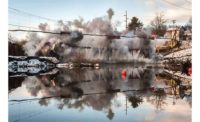The COVID-19 shutdowns of construction sites in New York and New Jersey during the first half of 2020 and financial concerns had a clear impact on the Top Starts list of projects that broke ground last year.
For the top 40 projects within the list of 60 ranked, compiled mostly from Dodge Data & Analytics as well as from information submitted by firms, the total cost of projects was $6.17 billion. That’s a steep drop of almost 62% from the $16.22 billion value of the largest 40 projects that began construction in 2019. But some sectors fared better than others.
Looking at the largest 60 starts, many project types fell under what was considered “essential construction” by both states’ governments: affordable housing, schools, health and medical facilities, infrastructure and utilities.
|
Related Link |
Clean Energy Looks Bright
In February 2020, the New Jersey Board of Public Utilities announced it had achieved installed solar capacity of 3,190 MW, up from 2,743 MW in the same month in 2019. The state continued building solar projects the rest of the year.
By January 2021, NJBPU announced the completion of the first solar community project in New Jersey. Located in Perth Amboy, it was built by Solar Landscape as part of the board’s solar energy pilot program.
“It’s specifically for our low- and moderate-income communities,” NJBPU President Joseph Fiordaliso says. He sees adoption of solar as a two-pronged approach, from small projects catering to specific communities to large projects that provide energy to the whole state or grid.
“Everyone should have the opportunity to participate in green energy no matter where they live,” Fiordaliso says. In urban areas, people who live in multifamily housing can’t put panels on their roofs, “so community solar allows that opportunity.”
The board’s solar energy pipeline as of Jan. 31 comprises 12,643 projects, including 42 for communities and 10 for grid supply. The state currently has 149,565 solar projects installed, “more solar projects than any state in the union,” Fiordaliso says. He imagines former brownfields will become sites for massive solar arrays.
Overshadowing the sun may be the wind, at least in headlines about New Jersey’s massive future offshore wind energy projects. Planning continues for the $1.6-billion, 1,100-MW Ocean Wind, to be located 17 miles offshore in the Atlantic and built byh Orsted, which won the contract in 2019. Fiordaliso says the state will award “the second solicitation” for offshore wind “in May or the beginning of June for up to 2,400 MW” of wind energy.
“I don’t see wind groundbreaking this calendar year, but I do see the federal government awarding permits at a faster pace under the Biden administration,” he says.
In 2020, NJBPU and the New Jersey Economic Development Authority also approved $6 million more for offshore wind and other clean energy projects. This includes increasing the state’s network of electric vehicle charging stations from 300 today to more than 1,000 that are publicly accessible by the end of 2025.
Green energy and infrastructure is being strongly pursued by New York's state government as well—and the New York State Energy Research and Development Authority, has been named the region's Owner of the Year.
Public Housing Improvements
Along with utilities and infrastructure, affordable housing projects were not as negatively impacted by pandemic-induced shutdowns. In seventh place on the region’s Top Starts list is the Capital Projects Program Management and Replacement of Boilers and Hot Water Heaters by the New York City Housing Authority.
The agency is spending about $224 million for these improvements at the following housing developments: Sotomayor, Farragut Houses, Taft Houses, Cypress Hills, Long Island Baptist, Robinson Houses, Fiorentino Plaza, Morris I and II and Morrisania.
According to a submission by AECOM, which is on the project management team, old heat and hot water systems “were often prone” to failures and leaks and would go “offline for extended periods of time to make repairs, causing residents to suffer through extended periods of unreliable heat and water service.”
The buildings now or soon will have new energy efficient boilers and “modified heating and hot water systems” that will need less fuel, be able to be turned off during summertime, have improved maintenance processes and reduce wear and tear, the submission says.
in Perth Amboy, infrastructure work continued during the pandemic on the $247.9-million Raritan River Bridge Replacement GC-01, which was ranked No. 6 on the Top Starts list. The movable swing-span bridge is the only link for most North Jersey Coast Line stations to Newark and Manhattan, according to another project submission from AECOM, whose joint venture with Mott MacDonald is part of the project team.
Vertical Lift Bridge
The existing bridge “was not designed to withstand the lateral forces due to ocean surges” and was knocked out of alignment and suffered damage during Superstorm Sandy.
The replacement will be a vertical lift bridge “providing a new two-track movable span” across the river. The structure will link back to the existing North Jersey Coast Line mainline tracks at its northern and southern ends. The project is slated to be completed in October 2024.








Post a comment to this article
Report Abusive Comment